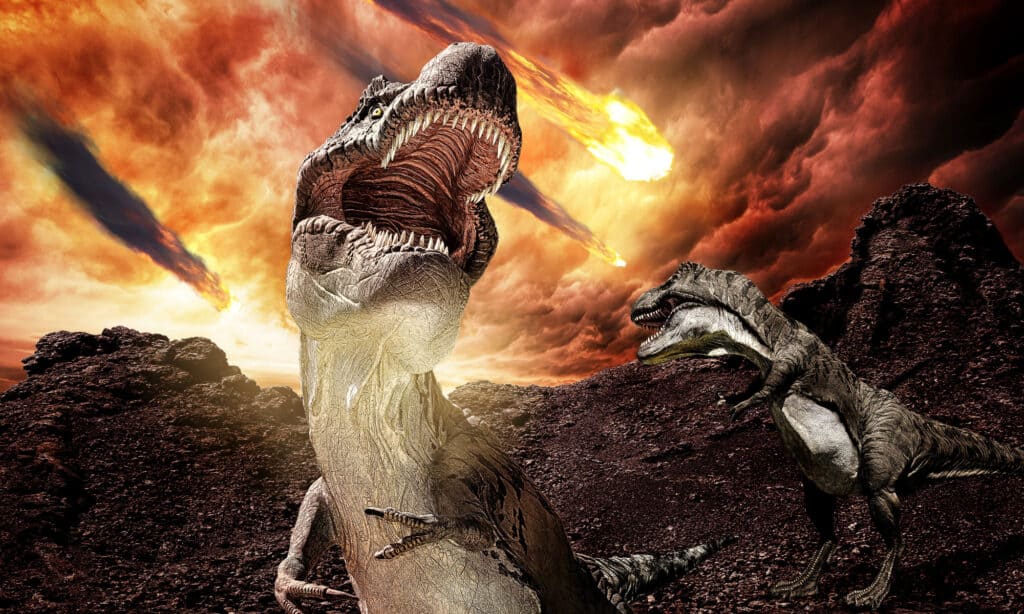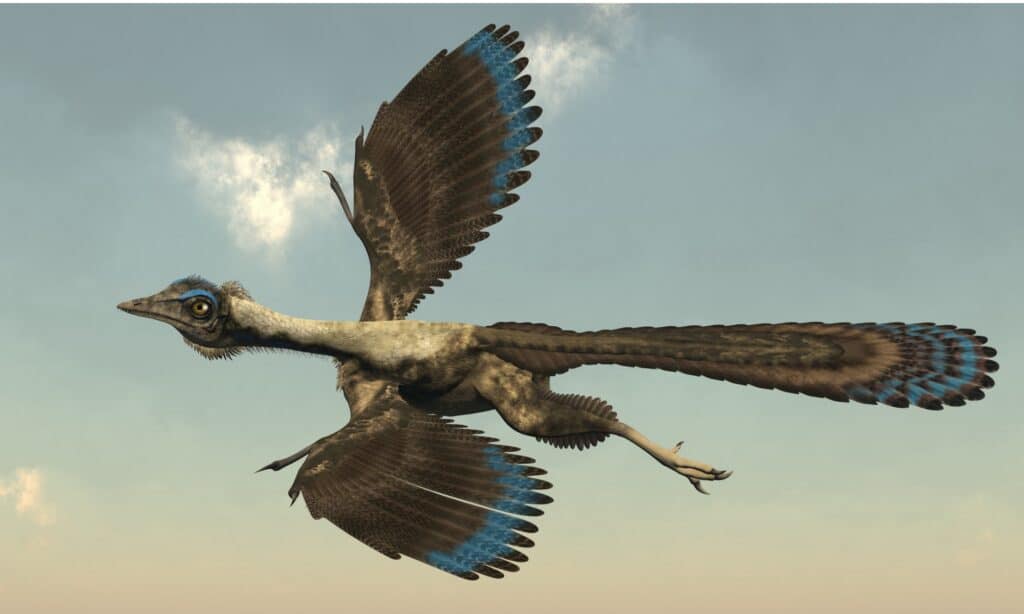Dinosaurs were the largest animals to ever exist but how did they go extinct? They lived during the Mesozoic Era and they witnessed the separation of the continents. This isolated early dinosaurs which caused waves of evolution and extinction among their ranks.
Around 66 million years ago, something caused almost all dinosaurs to suddenly disappear. After a reign of over 160 million years, something drastic must have happened. How did dinosaurs go extinct?
How Did Dinosaurs Go Extinct?

Dinosaurs becmes extinct as a result of an asteroid colliding with Earth.
©serpeblu/Shutterstock.com
Cataclysmic events drastically altered the earth at almost the exact time as the extinction of the dinosaurs. Volcanic activity, an asteroid impact, or a combination of the two immediately changed ecosystems and altered all life.
The Chicxulub Impact Crater in the Yucatan Peninsula provides evidence of a catastrophic disaster that befell the earth at the exact time that the dinosaurs vanished. At nearly the same geological moment, the Deccan Traps were formed through massive volcanic activity in India which had worldwide consequences. No one is sure if one or both of these events were the linchpin in the dinosaur’s extinction.
The meteor that hit the earth was 6 miles wide while the lava fields were 200,000 square miles long and 6,000 feet deep. These two events are capable of producing the kinds of geological and atmospheric consequences needed to cause an extinction event.
What Happened After the Chicxulub Asteroid Event?
An example of the kind of catastrophic conditions that were created by these disasters is rock precipitation. Fossilized fish that were buried alive by the jumping sediment in their waterways in the earthquakes that followed the Chicxulub asteroid had small crystallized rock fragments in their gills. This shows that liquid rock shot into the atmosphere from the immediate impact crystallized and rained down from the sky effectively choking vast amounts of life with rock particles.
That alone is devastating but it was just a couple of the results of the asteroid impact. Long-term effects like vitamin D3 deficiency due to reduced sunlight could have weakened dinosaur shell eggs. This would have wiped out any attempts at reproduction by members of the dinosaur community that had managed to survive.
Pollutants in the atmosphere triggered severe winter conditions for long periods across the planet. This caused the mass dieoff of plankton and terrestrial plants that are the foundation of food chains. All food became scarce and animals starved.
When Did Dinosaurs Go Extinct?

Dinosaurs became extinct approximately 66 millon years ago.
©Herschel Hoffmeyer/Shutterstock.com
Dinosaurs went extinct during the Cretaceous extinction event around 66 million years ago. This mass extinction marks the end of the Cretaceous Era and the beginning of the Paleogene Era. This is when the Chicxulub asteroid and Deccan Traps disasters occurred.
The Cretaceous-Paleogene extinction event 66 million years ago erased 75% of all plant and animal life on the planet. No large animals survived, excluding animals like crocodiles that were able to hide, slow their metabolisms, and wait out the devastation.
This extinction event is also known as the Cretaceous-Tertiary or K-T extinction. This is the 5th extinction event that’s occurred since life began.
Were Dinosaurs Slowly Going Extinct?
Dinosaurs may have been on the decline before a monumental event killed them off 66 million years ago. There is evidence that ecosystem changes taking place during the Cretaceous were leading to progressive deforestation. This resulted in more fungal spores in the air released from newly loosened soil.
These fungal spores may have caused serious infections in animals with colder blood than mammals. Mammals are well protected against most fungal infections because their high ambient body temperature is hostile to fungal growth. Dinosaurs may have been too cold-blooded to overcome this new threat.
Did All of the Dinosaurs Go Extinct?

Dinosaurs such as
Archaeopteryxsurvived the extinction event.
©iStock.com/Elenarts108
No, every living dinosaur on earth did not go extinct. A select number of feathered avian dinosaurs survived and evolved into modern birds. All of the flying reptiles died out when the dinosaurs went extinct.
Birds descend from a feathered raptor-esque dinosaur named Archaeopteryx that lived 150 million years ago. It had claws and teeth.
Common chickens are direct yet distant dinosaur descendants. Their three front toes and s-shaped neck are traits inherited from their dinosaur genes.
What Animals Survived the Extinction of the Dinosaurs?
Mammals, birds, turtles, and crocodiles all survived the extinction of the dinosaurs. Mammals thrived in the void left by the disappearance of dinosaurs and came to dominate the planet. Almost all animals weighing more than 50 pounds died.
Twice as many animals survived the dinosaur extinction event in the southern hemisphere as opposed to the north. That’s because it was probably early June and in turn late spring in the northern hemisphere when the asteroid hit. Animals weren’t burrowed or hiding and a new generation of young was being reared.
Animals that consumed detritus, like worms, seemed to have survived the extinction event since their food source was abundant. This allowed other animals to use these animals as a food source. As a result, new ecosystems started to develop from what was left behind by natural disasters.
If dinosaurs hadn’t disappeared, mammals wouldn’t have risen to dominance. Perhaps humans wouldn’t have evolved without their sudden disappearance.
What Makes an Animal a Dinosaur?

All dinosaurs had legs directly underneath their body.
©iStock.com/dottedhippo
An animal alive during the Mesozoic Era was a dinosaur if it was in the clade Dinosauria. These animal share anatomical, reproductive, and other physical characteristics.
A dinosaur had legs positioned directly underneath its body. Other lizards at the time had legs almost parallel to their walking surface. This results in two completely different walking styles which allowed dinosaurs better ease of movement on land.
Animals like pterosaurs and plesiosaurs are not considered dinosaurs. They had reptilian stances, not the characteristic upright posture of a real dinosaur. There are far fewer real dinosaurs than most people realize.
All dinosaurs laid eggs and almost all of them lived on the land since they were designed for it. No real dinosaurs could fly and none of them had fur.
Every type of dinosaur had a special muscle running through holes behind its eye socket that strengthened its jaw. This gave them their famously strong bite force.
Up Next
- Top 10 World’s Largest Dinosaurs Ever
- When Did Dinosaurs Go Extinct?
- How Long Were Dinosaurs On Earth?
The photo featured at the top of this post is © serpeblu/Shutterstock.com
Sources
- Science Direct, Available here: https://www.sciencedirect.com/science/article/abs/pii/S1087184504001938
- National Library of Medicine, Available here: https://www.ncbi.nlm.nih.gov/pmc/articles/PMC6425225/
Thank you for reading! Have some feedback for us? Contact the AZ Animals editorial team.







